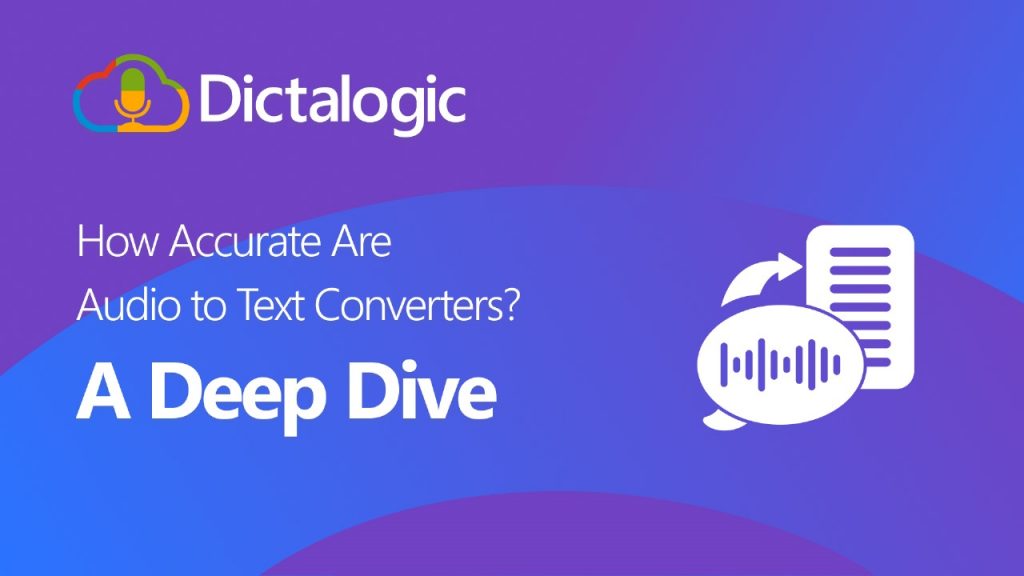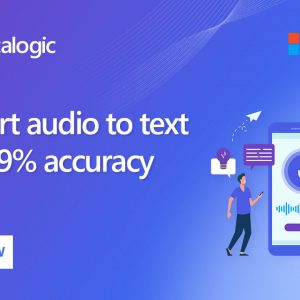The digital age speeds up our lives, which makes audio to text converters essential for every user type, including professionals, students, and content creators. Our audio handling processes are changing through tools that transform audio into text for interviews and lectures. However, the primary concern remains: What level of accuracy do audio to text converters produce? Below, we explore what these converters can do and what holds them back while examining reasons that determine their accuracy levels.

What Are Audio to Text Converters?
Audio to text converters use special computer programs to convert spoken words to written text. The system analyzes audio files using Automatic Speech Recognition technology connected to AI and ML systems.
Different organizations, including healthcare providers and businesses, combine these tools into their operations to expedite professional workflows and boost output rates nationally.
Factors That Influence the Accuracy of Audio to Text Converters
The accuracy of these tools relies on many factors, including:
1. Audio Quality
Clear audio recordings with minimal background noise produce better transcription results. Poor audio quality, excessive echoes, or overlapping voices can reduce accuracy.
2. Speaker Clarity
The way a speaker enunciates words greatly affects transcription accuracy. Fast speech, heavy accents, or mumbling can confuse advanced ASR systems.
3. Vocabulary and Context
Converters trained in industry-specific jargon or unique terminologies tend to perform better in niche scenarios. General purpose converters may struggle with specialized vocabulary.
4. Language Support
Multilingual support is a significant factor in assessing accuracy. Many converters excel in English but might falter when transcribing less common languages or dialects
5. Real-Time vs. Pre-Recorded Audio
Real-time transcription introduces challenges due to the lack of editing opportunities, whereas pre-recorded audio allows systems to process data more thoroughly.
How Accurate Are Popular Audio to Text Converters?
Here’s a closer look at the accuracy of leading tools:
1. Google Speech-to-Text
Google’s tool boasts high accuracy due to its advanced machine-learning models. It supports over 120 languages and adapts well to accents, provided the audio is clear.
2. Otter.ai
Popular among professionals, Otter.ai offers up to 90% accuracy for general-purpose transcription. It’s especially praised for its speaker identification features.
3. Dictalogic
Dictalogic, a robust transcription tool, provides exceptional accuracy across industries. Its adaptive algorithms ensure precise transcription even in noisy environments.
4. IBM Watson Speech-to-Text
IBM Watson offers enterprise-level transcript quality because it uses Artificial Intelligence and Natural Language Processing methods.
Strengths of Modern Audio to Text Converters
1. Speed
Many audio to text tools can transcribe in real-time, saving hours of manual labor.
2. Scalability
With cloud-based processing, these tools can handle large-scale transcription projects efficiently.
3. Integration Capabilities
Popular converters integrate seamlessly with platforms like Zoom, Microsoft Teams, and CRM systems.
4. Cost-Effectiveness
Compared to manual transcription services, these tools offer a more budget-friendly alternative without compromising speed.
Limitations of Audio to Text Converters
While these tools are advanced, they aren’t without flaws:
- Accents and Dialects: Converters often struggle to process thick accents or regional dialects accurately.
- Multiple Speakers: Conversations with overlapping dialogues can confuse even sophisticated algorithms.
- Complex Background Noise: Audio files with substantial noise or interruptions may yield inaccurate results.
- Limited Emotional Context: ASR systems cannot interpret sarcasm, tone, or emotions.
How to Improve Accuracy in Audio to Text Conversions
Here are actionable tips to maximize transcription accuracy:
1. Ensure High-Quality Audio
Use professional-grade recording equipment to minimize background noise and capture clear sound.
2. Speak Clearly and Slowly
Encourage speakers to enunciate words and avoid overlapping conversations during recordings.
3. Use Domain-Specific Tools
Opt for tools trained in your industry’s vocabulary for better results. For example, Dictalogic offers tailored solutions for healthcare, legal, and corporate sectors.
4. Edit and Review
Post-transcription editing is crucial for achieving near-perfect accuracy. Human proofreading can eliminate residual errors.
5. Train the Software
Some tools allow users to upload custom glossaries or train the model on specific terminologies.
Industries Benefiting from Accurate Audio to Text Conversions
1. Healthcare
Doctors use transcription tools to convert voice notes into patient records, improving efficiency and accuracy in documentation.
2. Media and Journalism
Transcription tools help reporters do their job faster by recording interview content so they can produce stories sooner.
3. Education
Students and teachers apply these tools to convert classroom recordings and digital learning materials for their improved understanding.
4. Business
Improved team communication results from recording meetings and discussions so teams can access them later.
5. Legal
Lawyers need transcription tools to produce precise written records of courtroom discussions and client conversations.
The Future of Audio to Text Conversion
Modern AI and deep learning technologies will bring new possibilities to transcription.
- Contextual Understanding: AI models are increasingly focusing on understanding context to improve accuracy.
- Real-Time Emotion Analysis: Future workflow tools may integrate tone and emotional recognition for nuanced transcriptions.
- Enhanced Multilingual Support: Globalized technology will focus on catering to diverse languages and dialects.
Choosing the Right Audio to Text Converter: Key Considerations
When selecting a transcription tool, consider the following:
- Use Case: Determine whether you need real-time transcription or offline processing.
- Language Support: Ensure the tool supports your required language and dialect.
- Integration: Check if the tool integrates with your existing platforms and workflows.
- Customization: Look for features like custom dictionaries or industry-specific models.
Dictalogic: A Leader in Transcription Technology
Dictalogic is a leading transcription service because it provides precise results while serving many users and feels simple to use. Dictalogic uses advanced artificial intelligence and machine learning technology to produce reliable transcription services for all business sectors.
Why Choose Dictalogic?
- High Accuracy: Ensures precise transcriptions even in noisy environments.
- Industry Adaptability: Our services adjust to serve legal firms, healthcare organizations, and business clients.
- Affordable Pricing: Small and large companies can start with Audio to text because its rates are affordable.
- Continuous Updates: The tool updates its features regularly to stay ahead of the field.
Conclusion
The latest technology for automated audio processing transforms the workflow for handling audio data. No matter what difficulties lie ahead, computer transcription has achieved significant advancements. Choosing the right tool and understanding accuracy aspects allows users to create nearly perfect output.
For unparalleled transcription accuracy and efficiency, Dictalogic is a top choice. Its innovative features and adaptability make it a trusted partner for professionals seeking reliable audio to text solutions.

